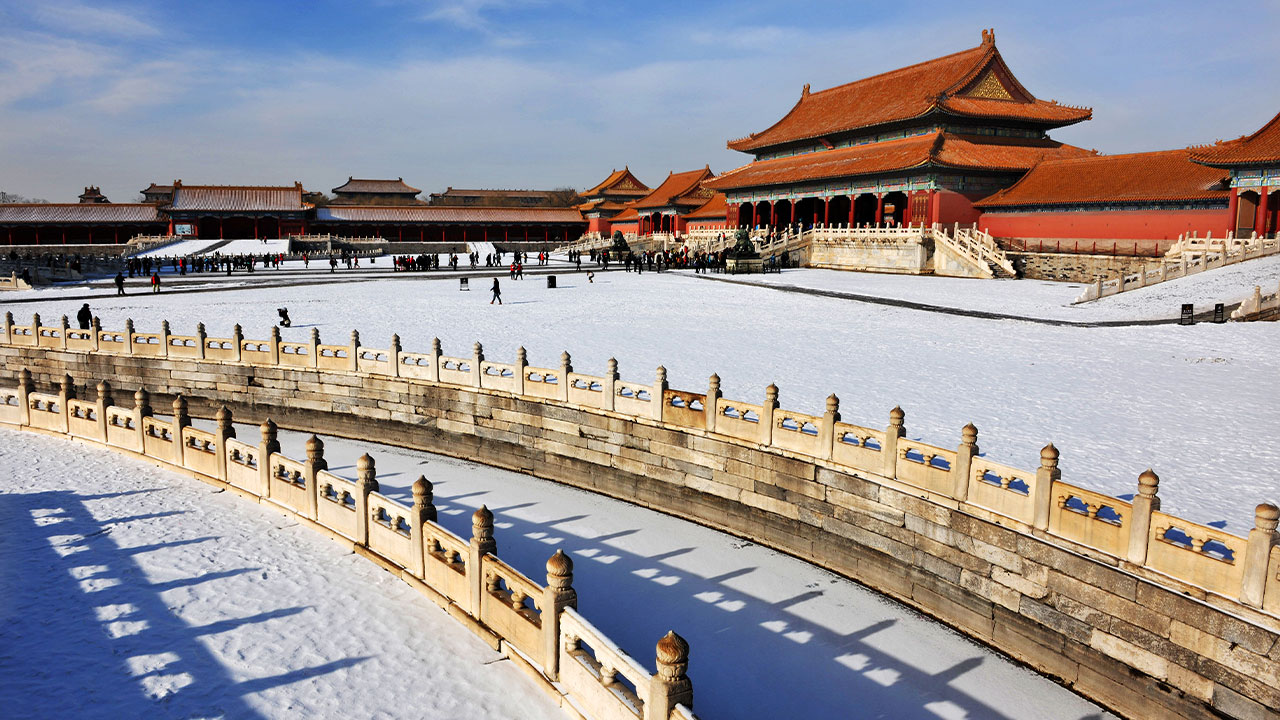The Forbidden City

The Forbidden City is located at the center of Beijing's central axis, occupying a prominent position in the heart of the city. It was built during the Yongle period of the Ming Dynasty (1368-1644) and took 14 years to complete.
It is rectangular in shape, with a length of 961 meters and a width of 753 meters. Surrounding the Forbidden City is a 10-meter-high wall, with a moat 52 meters wide serving as an additional layer of defense. The Forbidden City covers an area of 1,120,000 square meters. Each side of the rectangular city has a gate. There are four gates to the Forbidden City: the Meridian Gate (午门) in the south, the Gate of Divine Prowess (神武门) in the north, the East Gate (东华门) in the east, and the West Gate (西华门) in the west. The Forbidden City has about 9,999 rooms.
Each corner of the wall features an intricately designed corner tower, adding to the complex's architectural beauty. For different functions, the Forbidden City is divided into the Outer Court and the Inner Court. The Outer Court was the venue for the emperor’s court and grand audiences. The southern portion of the Forbidden City features three main halls – the Hall of Supreme Harmony (Taihe dian), Hall of Central Harmony (Zhonghe dian), and Hall of Preserving Harmony (Baohe dian).
Mirroring this arrangement is the Inner Court, which is the northern portion of the Forbidden City. The Inner Court is not only comprised of the residences of the emperor and his consorts but also venues for religious rituals and administrative activities.
The Forbidden City is not only the essence of ancient Chinese palace architecture, but also an important embodiment of the cultural renaissance of the Ming Dynasty. The following aspects of the Forbidden City from several detailed description of how to reflect the revival of the Ming Dynasty:
First, the architectural layout and style
Overall Layout: The Forbidden City covers a vast area surrounded by high walls and moats, and is laid out in the traditional Chinese courtyard style. It consists of the outer court, where courtiers work and hold ceremonies, and the inner court, where the emperor and his family live. This layout reflects the architectural rigor and grandeur of the Ming Dynasty.
Palace Architecture: The Forbidden City has many palaces. These palaces are richly decorated and meticulously carved, showing the essence of ancient Chinese architecture. The architectural layout of the palace is rigorous and highly ceremonial, expressing the symbolism of honoring imperial power and sanctity. Among them, as a place to hold major celebrations, the scale and grandeur of the Hall of Supreme Harmony is the pinnacle of Ming Dynasty architecture.
Second, architectural details and decoration
Yellow glazed tiles and red walls: the palace roofs generally use yellow glazed tiles, and the walls are red. This color scheme is not only bright and eye-catching, but also signifies the royal dignity and sanctity. This color scheme and architectural style were widely promoted and applied in the Ming Dynasty, becoming one of the important features of Ming Dynasty architecture.
Carving and Painting: The carving and painting art in the Forbidden City also reflects the high skill of the Ming Dynasty. Whether it is the palace's beams, squares, arches, or the carvings on doors and windows, they are all lifelike and skillfully crafted. The painting is even more colorful, with exquisite patterns that not only showcase the achievements of Ming Dynasty painting art but also contribute to the magnificent atmosphere of the palace.
Third, wooden structure and frames
The Forbidden City is the largest and most complete complex of ancient timber-framed buildings in the world.
High-quality wooden beams and columns were used for the main frames of all the buildings, including whole trunks of the precious Phoebe southwood from the jungles of southwestern China. The Forbidden City carpenters used interlocking mortise and tenon joints to “harmonize” the magnificent palace buildings without nails.
The Forbidden City is not only a palace, but also a symbol and heritage of traditional Chinese culture. The architectural features and cultural renaissance of the Forbidden City embody the essence of Chinese architecture and art, and as China's cultural heritage, it shows the world the treasures of ancient Chinese civilization.